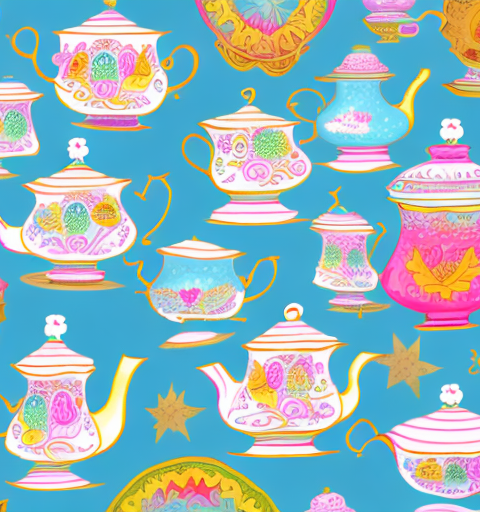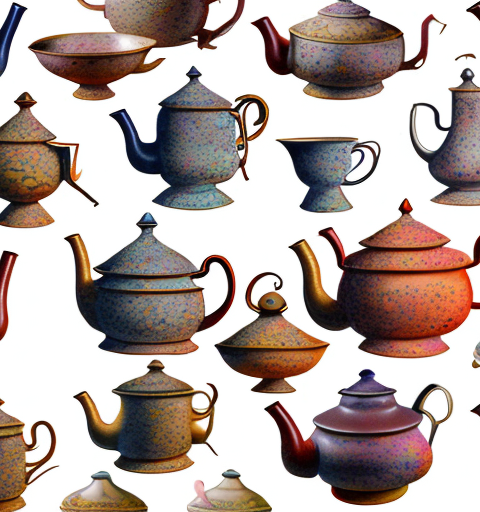Tea lovers around the world often seek new ways to enhance their tea drinking experience. One question that frequently arises is whether a ceramic teapot can be used for brewing tea blends with a complex and layered taste. In this article, we will delve into the role of teapots in brewing tea, explore the benefits of using a ceramic teapot for tea blends, and uncover the secrets to brewing tea blends with depth and complexity.
Understanding the Role of Teapots in Brewing Tea
Teapots have been a staple in tea culture for centuries, playing a vital role in the preparation of tea. They serve as vessels for steeping loose tea leaves in hot water, allowing the flavors and aromas to infuse. The design and material of the teapot can influence the brewing process and ultimately impact the taste and characteristics of the tea. Ceramic teapots, in particular, are known for their ability to preserve heat and provide an optimal environment for tea leaves to release their full potential.
In addition to ceramic teapots, other materials commonly used for teapots include glass, cast iron, and stainless steel. Each material has its own unique properties that can affect the brewing process. Glass teapots, for example, allow for a visually appealing experience as the tea leaves unfurl and dance in the water. Cast iron teapots are known for their durability and heat retention, making them ideal for brewing certain types of tea, such as Japanese green teas. Stainless steel teapots are often favored for their sleek and modern design, as well as their ability to retain heat. Ultimately, the choice of teapot material depends on personal preference and the type of tea being brewed.
Exploring the Benefits of Using a Ceramic Teapot for Tea Blends
When it comes to brewing tea blends with a complex and layered taste, ceramic teapots offer several advantages. Firstly, ceramic is an excellent heat insulator, ensuring that the water remains at the desired temperature throughout the steeping process. This is crucial for extracting the delicate and nuanced flavors from the tea leaves. Additionally, ceramic teapots distribute heat evenly, preventing any hotspots that could result in over-extraction or uneven flavors.
Moreover, ceramic teapots are non-reactive, meaning they won’t impart any unwanted flavors or alter the taste of the tea. This quality allows for a pure and untainted tea-drinking experience, allowing the true essence of the tea blend to shine through. The porous nature of ceramic also helps retain the heat of the tea for a longer period, ensuring that each sip is still warm and enjoyable.
Another benefit of using a ceramic teapot for tea blends is its durability. Ceramic is known for its strength and resistance to cracks and chips, making it a long-lasting option for tea enthusiasts. This means that you can enjoy your favorite tea blends for years to come without worrying about the teapot breaking or deteriorating.
In addition, ceramic teapots are aesthetically pleasing and can enhance the overall tea-drinking experience. With their elegant and timeless designs, ceramic teapots can add a touch of sophistication to any tea ceremony or gathering. Whether you prefer a classic white teapot or a vibrant, hand-painted one, ceramic teapots offer a wide range of options to suit your personal style and preferences.
The Art of Brewing Complex and Layered Tea Blends
Brewing tea blends with a complex and layered taste requires finesse and attention to detail. To achieve the desired result, it is important to select the right tea blend and understand its unique characteristics. Each tea blend has its own brewing parameters, such as water temperature and steeping time, that need to be fine-tuned for an exceptional cup of tea.
When using a ceramic teapot, it is recommended to preheat the teapot with hot water to ensure the temperature is consistent throughout the brewing process. This step helps unlock the full flavors of the tea leaves and ensures a more balanced cup of tea. Additionally, using the correct water temperature specific to the tea blend is crucial, as it can greatly affect the extraction and taste of the tea.
Furthermore, the quality of the water used in brewing tea blends is often overlooked but plays a significant role in the final taste. Ideally, filtered or spring water should be used to avoid any impurities or chlorine that can alter the flavor of the tea. The mineral content of the water can also impact the taste, with some teas benefiting from softer water while others thrive in harder water.
Choosing the Right Ceramic Teapot for Enhanced Flavor Profiles
Choosing the right ceramic teapot is essential for enhancing the flavor profiles of tea blends. Consider factors such as the size and shape of the teapot, as well as the material used in its construction. The size of the teapot should accommodate the desired amount of tea leaves and water, allowing for proper expansion and extraction of flavors.
Furthermore, the shape of the teapot can influence the way flavors and aromas develop. Teapots with a wide base and narrow opening help retain heat and allow for a more concentrated infusion. On the other hand, teapots with a broader opening may result in a gentler extraction and lighter flavors. Experimenting with different teapot shapes can lead to fascinating discoveries and new taste experiences.
In addition to size and shape, the material used in the construction of a ceramic teapot can also impact the flavor profiles of tea blends. Porcelain teapots, for example, are known for their ability to retain heat and distribute it evenly, resulting in a more balanced and full-bodied infusion. Stoneware teapots, on the other hand, have a natural earthiness that can enhance the flavors of certain teas, such as oolong or pu-erh.
Another important consideration when choosing a ceramic teapot is the presence of a built-in infuser. Teapots with built-in infusers allow for easy steeping and removal of tea leaves, ensuring a clean and hassle-free brewing process. This feature is particularly beneficial for loose leaf tea enthusiasts who prefer the convenience of a teapot over individual infusers or tea bags.
Unveiling the Secrets to Brewing Tea Blends with Depth and Complexity
There are a few secrets to brewing tea blends with depth and complexity. Firstly, using fresh, high-quality tea leaves is paramount. Stale or low-quality leaves may lack the desired flavors and complexities. Secondly, understanding the ratios of tea leaves to water is crucial. Too many leaves can result in a bitter brew, while too few may yield a weak and lackluster cup of tea.
Another important aspect is experimenting with brewing techniques. For example, incorporating a rinse before the first steep can awaken the flavors and enhance the layers of the tea blend. Additionally, adjusting the steeping time for subsequent infusions can bring out different nuances and complexities. The beauty of tea lies in its versatility, and with the right techniques, a ceramic teapot can unlock its full potential.
Furthermore, the temperature of the water used for brewing tea blends can greatly impact the final result. Different types of tea require different water temperatures to bring out their unique flavors. For example, delicate green teas are best brewed with water that is around 175°F, while robust black teas can handle boiling water at 212°F. It is important to pay attention to the recommended water temperature for each tea blend to achieve the desired depth and complexity.
In addition to the brewing process, the quality of the water itself can also affect the taste of the tea. Using filtered or spring water can help remove any impurities or chlorine that may alter the flavor of the tea. It is recommended to avoid using distilled or heavily chlorinated tap water, as they can negatively impact the overall taste and aroma of the tea blend. By using high-quality water, you can ensure that the true flavors and complexities of the tea are fully showcased.
Enhancing Tea Flavor with a Ceramic Teapot: Tips and Tricks
To truly enhance the flavor of tea blends with a ceramic teapot, consider the following tips and tricks. Firstly, warm the teapot by rinsing it with hot water before brewing. This helps maintain a consistent and optimal temperature throughout the brewing process.
Moreover, using a tea cozy or a warmer to insulate the teapot further can retain heat and even improve the flavor extraction. It is also recommended to steep the tea for the appropriate duration, as over-brewing can lead to bitterness, while under-brewing may result in a lack of complexity.
Lastly, avoid overfilling the teapot, as this can restrict the expansion of leaves and hinder the extraction of flavors. Aim for a balance between the amount of tea leaves and water to achieve the desired strength and taste.
Additionally, the quality of the water used can greatly impact the flavor of the tea. It is recommended to use filtered or spring water, as tap water may contain impurities that can alter the taste. The purity of the water allows the true flavors of the tea to shine through.
Furthermore, the type of tea leaves used can also affect the flavor when brewing in a ceramic teapot. Different teas have different brewing requirements, so it is important to follow the recommended brewing instructions for each specific type of tea. This will ensure that the flavors are fully extracted and the tea is brewed to perfection.
The Science Behind Using a Ceramic Teapot for Complex Tea Blends
The science behind using a ceramic teapot lies in its ability to provide an optimal environment for brewing tea. Ceramic is an excellent heat insulator, which means that the water temperature remains constant, allowing for a more controlled extraction of flavors from the tea leaves.
Additionally, the porous nature of ceramic helps with heat retention, preserving the warmth and flavor of the tea for a longer period. This is especially beneficial for complex tea blends that develop their flavors over multiple infusions. The non-reactive nature of ceramic ensures that the taste of the tea remains unadulterated, providing a pure and authentic tea-drinking experience.
Mastering the Technique: Brewing Layered Tea Blends in a Ceramic Teapot
Brewing layered tea blends in a ceramic teapot requires a combination of technique and patience. Start by selecting a tea blend that is specifically known for its complexity and layers. Follow the recommended brewing parameters for water temperature, tea-to-water ratio, and steeping time, as provided by the tea manufacturer or based on personal preference.
Ensure that the ceramic teapot is preheated to maintain a consistent temperature. Gently add the tea leaves to the teapot, allowing them to steep for the specified time. When pouring the brewed tea, use a slow and controlled motion to prevent any excess water from diluting the flavor. By refining the technique and mastering the brewing process, one can unlock the full potential of a layered tea blend in a ceramic teapot.
Unlocking the Full Potential of Your Ceramic Teapot for Flavorful Tea Blends
To unlock the full potential of your ceramic teapot for brewing flavorful tea blends, there are a few additional considerations. Pay attention to the cleanliness of the teapot, as any previous residue or oils can impact the taste of the tea. Clean the teapot thoroughly after each use to maintain its original flavors.
Furthermore, embrace experimentation and exploration with different tea blends and types of teapots. Each teapot material, shape, and size can contribute to unique taste experiences. By discovering the perfect combination for your preferences, you can truly unlock the full potential of your ceramic teapot and enjoy the complexities and layers of your favorite tea blends.
Exploring Different Types of Ceramic Teapots for Unique Taste Experiences
Ceramic teapots come in various types and styles, each offering its own unique taste experiences. Some popular types include porcelain, stoneware, and earthenware. Porcelain teapots are known for their ability to preserve the natural taste of the tea, while stoneware teapots often enhance the body and mouthfeel of the brew.
Earthenware teapots, on the other hand, can lend a rustic and earthy quality to the tea. Exploring different types of ceramic teapots allows tea enthusiasts to experiment with different taste profiles and discover new dimensions within their favorite tea blends.
Elevate Your Tea Experience: How a Ceramic Teapot Enhances Aroma and Taste
A ceramic teapot can elevate your tea experience by enhancing both the aroma and taste of the brew. The porous nature of ceramic traps and amplifies the aromas, allowing them to develop and linger as you savor each sip. This adds an additional layer of enjoyment as you appreciate the fragrance of the tea.
Moreover, the heat retention and even distribution offered by ceramic teapots ensure that the tea brews to its full potential, resulting in a well-balanced and flavorful cup of tea. By using a ceramic teapot, you can truly elevate and enhance the overall tea-drinking experience.
An Expert’s Guide to Brewing Tea Blends with a Complex and Layered Taste in a Ceramic Teapot
For those seeking an expert’s guide to brewing tea blends with a complex and layered taste in a ceramic teapot, consider the following steps. Begin by selecting a high-quality tea blend known for its complex flavors. Preheat the ceramic teapot and add the appropriate amount of tea leaves.
Next, pour hot water over the leaves, ensuring the water temperature is suitable for the specific blend. Allow the tea to steep for the recommended duration while following the brewing parameters provided by the tea manufacturer. Lastly, pour the brewed tea with care, savoring every sip and appreciating the layers and nuances of the tea blend.
The Perfect Pair: Choosing the Ideal Tea Blend to Brew in Your Ceramic Teapot
Choosing the ideal tea blend to brew in your ceramic teapot is a personal preference, but there are certain blends that pair exceptionally well with ceramic. Complex black teas, such as Darjeeling or Assam, often benefit from the heat retention and even brewing temperature offered by ceramic teapots.
Similarly, oolong teas with their layered flavors and floral notes can flourish in a ceramic teapot. Green teas, particularly those with delicate and nuanced flavors like Japanese Sencha or Dragon Well, also harmonize beautifully with ceramic. Ultimately, the perfect pairing lies in finding the tea blend that resonates with your taste buds and complements the characteristics of your ceramic teapot.
From Mild to Bold: Customizing Tea Flavors Using a Ceramic Teapot
A ceramic teapot provides the perfect canvas for customizing tea flavors, allowing you to go from mild to bold with ease. To achieve a milder flavor profile, consider using a lower temperature and shorter steeping time. This approach helps preserve the delicate flavors of the tea while minimizing bitterness.
For a bolder and more robust cup of tea, increase the water temperature and extend the steeping time. This leads to a stronger infusion, with deeper flavors and greater complexity. The versatility of a ceramic teapot empowers tea enthusiasts to tailor their brews according to their individual preferences.
In conclusion, a ceramic teapot can indeed be used for brewing tea blends with a complex and layered taste. Its unique properties, such as heat retention, even heat distribution, and non-reactive nature, contribute to a well-balanced and flavorful cup of tea. By considering various brewing techniques, selecting the right tea blends, and exploring different types of ceramic teapots, tea enthusiasts can unlock the full potential of their tea experience. So, grab your ceramic teapot, select your favorite tea blend, and embark on a journey of flavors and aromas that will surely delight your senses.






